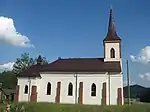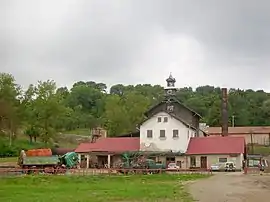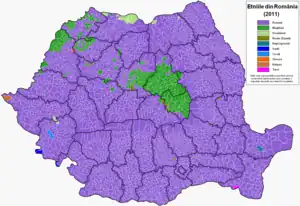Poles in Romania
According to the 2021 Romanian census, 2,137 Poles live in Romania,[1] mainly in the villages of Suceava County (Polish: Suczawa). There are three exclusively Polish villages, as follows: Nowy Sołoniec (Solonețu Nou), Plesza (Pleșa), and Pojana Mikuli (Poiana Micului), as well a significant Polish presence in Kaczyca (Cacica) and Paltynosa (Păltinoasa). There is also a relatively sizable number of ethnic Poles living in the county seat, Suceava (Polish: Suczawa).
.png.webp) Poles in Romania (2002 census) | |
| Total population | |
|---|---|
| 2,137 (2021) | |
| Regions with significant populations | |
| Suceava County | |
| Languages | |
| Polish, Romanian | |
| Religion | |
| Mainly Roman Catholicism, but also Greek Catholic and Orthodox | |
| Related ethnic groups | |
| Polish diaspora |
Poles in Romania form an officially recognised national minority, having one seat in the Chamber of Deputies (currently held by the Union of Poles of Romania) and access to Polish elementary schools and cultural centres (known as "Polish Houses" or "Dom Polski" in Polish).[2]
History
| Year | Pop. | ±% |
|---|---|---|
| 1930 | 48,310 | — |
| 1948 | 6,753 | −86.0% |
| 1956 | 7,627 | +12.9% |
| 1966 | 5,860 | −23.2% |
| 1977 | 4,641 | −20.8% |
| 1992 | 4,232 | −8.8% |
| 2002 | 3,559 | −15.9% |
| 2011 | 2,543 | −28.5% |
| 2022 | TBD | — |
| Official census data | ||


The first Poles settled in Moldavia in the times of Casimir III (specifically during the Late Middle Ages). Most of the Poles immigrating after 1774 were looking for work. So it was that Polish miners from Bochnia and Wieliczka were brought to salt mines in Cacica.
Another wave of Polish immigration arrived in Bukovina in the early 19th century, when the region was a crownland of the Austro-Hungarian Empire, as was a significant portion of present-day southern Poland (see: Kingdom of Galicia and Lodomeria).
Around 1803, Polish highlanders from Čadca (Polish: Czaca, Czadca) settled in Treblecz (Tereblecea, now in Chernivtsi Raion, Chernivtsi Oblast, Ukraine) by Siret, in Stara Huta Krasna and in Kaliczanka and again in 1814 to 1819, this time settling in Hliboka (Adâncata) and Tereszna. Nowy Sołoniec was settled in 1834, Plesza in 1835, and Pojana Mikuli in 1842.
At that time, it must be mentioned that Bukovina was a very attractive region of the Austrian Empire to live in thanks to Austria's policy not to conscript recruits into its army from there (service in the Austrian army at that time was for a 14-year term).
Furthermore, Bukovina was free from serfdom, primarily attracting immigrants of German (who later formed the basis of the Bukovina German community of the region), Jewish, and also Czecho-Slovak origin but also Polish ethnicity and even Russian and Italian.
There were probably other waves of migration from Poland after the November and Kraków Uprisings, but most Poles were from peasant families relocated there by the Empire's authorities after they participated in the Jakub Szela insurrection.
Communes with the highest Polish population percentage

- Suceava County
- Cacica — 20.04%
- Mănăstirea Humorului — 19.3%
- Mușenița — 4.06%
- Moara — 3.23%
- Păltinoasa — 1.14%
Notable Polish Romanians
- Marian Kielec, footballer
- Corneliu Zelea Codreanu, politician, founder of the Iron Guard
- Ioan Gyuri Pascu (partly Polish), musician, actor, and comedian
- Octavian Smigelschi (partly Polish), painter
- Stefan Norris (born in Poland; subsequently settled in Romania), art director
- Mărgărita Miller-Verghy, author, journalist, critic, and translator
- Wojciech Weiss, painter
- Leonard Mociulschi, major general
- Henri Cihoski, lieutenant-general
- Robert Sadowski, international footballer
- Michał Belina Czechowski, Seventh-Day Adventist preacher
- Ghervazen Longher, politician
- Adolf Zytogorski (born in Romania; moved to Poland then England), chess master and translator
- Tytus Czerkawski, politician
- Izydor Kopernicki, physician
- Iosif Malinovski, Roman Catholic vicar and publisher
- Gustaw Otręba, physician
- Witold Rola Piekarski, cartoonist and academic
- Feliks Wierciński, Roman Catholic priest and schoolteacher
Gallery

%252C_Ple%C8%99a_12.jpg.webp)

 The Polish House in Suceava (Polish: Dom Polski w Suczawie), built at the round of the 20th century (more specifically between 1903 and 1907)
The Polish House in Suceava (Polish: Dom Polski w Suczawie), built at the round of the 20th century (more specifically between 1903 and 1907) Polish newspaper in Romania
Polish newspaper in Romania The salt mine in Cacica (Polish: Kaczyka), Suceava county, southern Bukovina
The salt mine in Cacica (Polish: Kaczyka), Suceava county, southern Bukovina Roman Catholic basilica in Cacica
Roman Catholic basilica in Cacica%252C_Ple%C8%99a_01.jpg.webp) View from the village of Pleșa (Polish: Plesza)
View from the village of Pleșa (Polish: Plesza)%252C_Ple%C8%99a_14.jpg.webp) View from the village of Pleșa (Polish: Plesza)
View from the village of Pleșa (Polish: Plesza)%252C_Solone%C8%9Bu_Nou_09.jpg.webp) View from Solonețu Nou (Polish: Nowy Sołoniec)
View from Solonețu Nou (Polish: Nowy Sołoniec)%252C_Ple%C8%99a_03.jpg.webp) Natural landscape from the village of Pleșa (Polish: Plesza)
Natural landscape from the village of Pleșa (Polish: Plesza).jpg.webp) Natural landscape from the village of Pleșa (Polish: Plesza)
Natural landscape from the village of Pleșa (Polish: Plesza)
See also
References
- "Population and housing census, 2021 - provisional results | National Institute of Statistics". insse.ro. Retrieved 2023-08-13.
- Redacția Orașul Suceava. "Uniunea Polonezilor din România". Orașul Suceava (in Romanian). Retrieved 20 September 2022.
External links
- Map of Polish villages in Romania
- (in Polish) Polonia w Rumunii
- (in Polish and Romanian) Polscy uchodźcy w Rumunii 1939–1947. Dokumenty z Narodowych Archiwów Rumunii / Refugiații polonezi în România 1939–1947. Documente din Arhivele Naționale ale României, t. 1, cz. 1 i 2*The Polish organization in Romania
- Polish minority in Cacica - Romania (archive)

